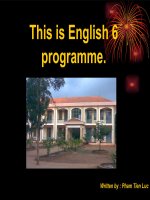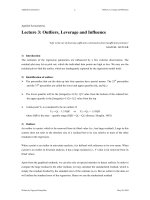Lecture Connections 13 | Bioenergetics and Reactions
Bạn đang xem bản rút gọn của tài liệu. Xem và tải ngay bản đầy đủ của tài liệu tại đây (2.29 MB, 56 trang )
Lecture Connections
13 | Bioenergetics and Reactions
© 2009 W. H. Freeman and Company
CHAPTER 13
Bioenergetics and Reactions
Key topics:
– Thermodynamics applies to biochemistry, too
– Organic chemistry principles are still valid
– Some biomolecules are “high energy” with
respect to their hydrolysis and group transfers
– Energy stored in reduced organic compounds
can be used to reduce cofactors such as NAD+
and FAD, which serve as universal electron
carriers
Life Needs Energy
• Recall that living organisms are built of complex
structures
• Building complex structures that are low in entropy
is only possible when energy is spent in the
process
• The ultimate source of this energy on Earth is the
sunlight
Metabolism Is the Sum of All
Chemical Reactions in the Cell
• Series of related reactions form metabolic pathways
• Some pathways are primarily energy-producing
– this is catabolism
• Some pathways are primarily using energy to build
complex structures
– this is anabolism or biosynthesis
Laws of Thermodynamics Apply
to Living Organisms
• Living organisms cannot create energy from nothing
• Living organisms cannot destroy energy into nothing
• Living organism may transform energy from one form to
another
• In the process of transforming energy, living organisms
must increase the entropy of the universe
• In order to maintain organization within the themselves,
living systems must be able to extract useable energy from
the surrounding, and release useless energy (heat) back
to the surrounding
Free Energy, or the Equilibrium
Constant Measure the Direction
of Spontaneous Processes
Hydrolysis Reactions tend to be
Strongly Favorable (Spontaneous)
Isomerization Reactions Have
Smaller Free Energy Changes
• Isomerization between enantiomers: G = 0
Complete Oxidation of Reduced
Compounds is Strongly Favorable
• This is how chemotrophs obtain most of their
energy
• In biochemistry the oxidation of reduced fuels
with O2 is stepwise and controlled
• Recall that being thermodynamically favorable
is not the same as being kinetically rapid
Lesson in Quantum Chemistry
• Most organic molecules, including the reduced fuels, are in
the singlet spin state
– All electrons are paired into electron pairs
• Molecular oxygen is in the triplet spin state
– Two electrons are unpaired
• Direct electron transfer from a singlet reduced species to a
triplet oxidizing species is quantum-mechanically forbidden
• This is why direct oxidation (spontaneous combustion) of
biomolecules does not occur readily
• Few cofactors, such as transition metal ions, and flavin
adenine dinucleotide are able to catalyze consecutive
single-electron transfers needed for utilization of O2
Review of Organic Chemistry
• Most reactions in biochemistry are thermal
heterolytic processes
• Nucleophiles react with electrophiles
• Heterolytic bond breakage often gives rise to
transferable groups, such as protons
• Oxidation of reduced fuels often occurs via
transfer of electrons and protons to a dedicated
redox cofactors
Chemical Reactivity
Most reactions fall within few categories:
•
Oxidations-reductions (e- transfers)
• Group transfers (H+, CH3+, PO32-)
• Cleavage and formation of C–C bonds
• Cleavage and formation of polar bonds
• Nucleophilic substitution mechanism
• Addition–elimination mechanism
• Hydrolysis and condensation reactions
• Internal rearrangements
• Eliminations (without cleavage)
Group Transfer Reactions
• Proton transfer, very common
• Methyl transfer, various biosyntheses
• Acyl transfer, biosynthesis of fatty acids
• Glycosyl transfer, attachment of sugars
• Phosphoryl transfer, to activate metabolites,
also important in signal transduction
Chemistry at Carbon
Covalent bonds can be broken in two ways
Homolytic cleavage is very rare, heterolytic cleavage
is common but does not occur for C-C bonds as
shown above
Nucleophiles and Electrophiles in
Biochemistry
Examples of Nucleophilic CarbonCarbon Bond Formation Reactions









